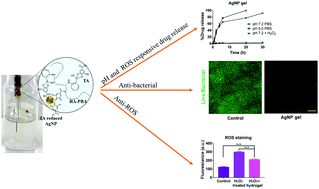Tannic acid-inspired, self-healing, and dual stimuli responsive dynamic hydrogel with potent antibacterial and anti-oxidative properties†
Abstract
Due to their intrinsic injectable and self-healing characteristics, dynamic hydrogels, based on dynamic covalent bonds, have gained a great attention. In this study, a novel dynamic hydrogel based on the boronic ester dynamic covalent bond is facilely developed using phenylboronic acid-modified hyaluronic acid (HA–PBA) and plant-derived polyphenol-tannic acid (TA). The dynamic hydrogel gelated quickly under mild conditions and had favorable viscoelastic properties with good self-healing and shear-thinning capabilities. Moreover, the simultaneous utilization of TA as a reductant for the green synthesis of silver nanoparticles (AgNP) inspired the preparation of a TA-reduced AgNP hybrid dynamic hydrogel with potent and broad-spectrum antibacterial activities. The dynamic hydrogels could also be applied for pH- and reactive oxygen species (ROS)-responsive release of loaded protein molecules without showing evident cytotoxicity and hemolysis in vitro. In addition, the dynamic hydrogels showed the anti-oxidative properties of high free radical and ROS scavenging capacity, which was verified by the DPPH (2,2-diphenyl-1-picryl-hydrazyl-hydrate) free radical assay and ROS fluorescence staining. Overall, this novel class of cytocompatible, self-healing, dual stimuli responsive, antibacterial, anti-oxidative, and injectable hydrogels could be promising as a wound dressing for chronic wound healing.

- This article is part of the themed collections: Journal of Materials Chemistry B Emerging Investigators and 2021 Journal of Materials Chemistry B most popular articles


 Please wait while we load your content...
Please wait while we load your content...